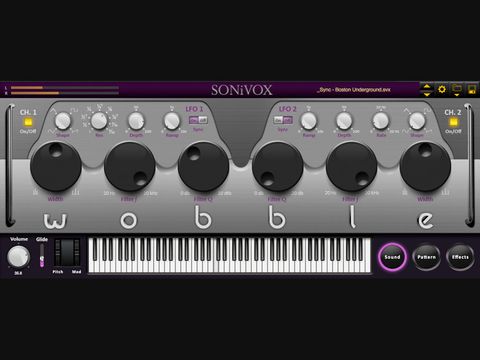Dubbed its Dubstep Grime Generator, this is the latest synth from Sonivox's Nemesynth group and, like its sibling Twist, it serves up its 'spectral morphing synthesis' via a large, knob-centric interface.
The main page features two separate synth 'channels'; these host a fixed pair of timbres for each of the 200 preset patches, with individual controls for Width, Tune (+/-1 semitone), Filter Cutoff, Filter Resonance and the syncable LFO (square, sine, triangle and sawtooth waveshapes).
"Wobble's strongest element is the Pattern Generator, and the inclusion of LFO Sync as a pattern parameter means that you can quickly summon up grime-style sounds with time-shifting wobble."
The Width knob is your main sound-tailoring control, adjusting harmonic frequency content in relation to fundamental pitch. Each patch comes with a pre-configured filter envelope, leaving the filter, tuning and LFO settings for further tweaking. Of course, the blending of the two channels also influences the sound.
On a separate Effects page are chorus, reverb and delay units, and rounding things off is the Pattern page, featuring a pattern generator andintelligent rhythm control (a real-time performance quantiser, essentially).
The main keyboard, with Modwheel, Pitchbend, Glide Time and Output Volume, stays visible at the bottom of the window at all times, and the vast majority of parameter knobs feature MIDI learn for controller assignments.
Rather oddly, the mod wheel assignment is set to control its own arbitrary internal parameters in each patch and can't be changed, although you can still assign the mod wheel's CC to the onscreen knobs.
Wobble's Pattern Generator enables synced control of six parameters: Note Offset, Width, Filter Cutoff, LFO Rate, LFO Depth and LFO Sync. All but Note Offset can be set individually for each synth channel.
Other features here include step joining for held notes, glide and velocity. It's a pretty good showing for this handy little pattern sequencer, then, although on the downside, you can't stop the pattern from retriggering on new MIDI notes, or trigger it via the onscreen 'board.
Brothers grime
Wobble's synth engine takes a bit of getting used to, and we found ourselves hunting through the 200 presets to find a good starting point. They lean heavily towards bass and leads, with effects, pads and stabs making up the minority.
However, the most important thing to understand is that there are hidden aspects to each patch, such as amp and filter envelopes, that can't be modified. We also found that, in some instances, Channel 1's LFO influences Channel 2, which is kind of weird. The upshot of this is that you can't really approach editing Wobble in the same way you would a more conventional soft synth.
Wobble's strongest element is the Pattern Generator, and the inclusion of LFO Sync as a pattern parameter means that you can quickly summon up grime-style sounds with time-shifting wobble.
Throw in some filter settings and a few note offsets, and hooky, rhythmic parts are easily created. Plus, you can change the current preset without losing the pattern settings, which is a nice touch.
While Wobble is clearly capable of producing some interesting (if not jaw-dropping) sounds, even low-level tweakers will find the lack of regular sound shaping parameters annoying. Couple this with the clunky preset management system, and itcould be easy for its strengths (the Pattern Generator and simple MIDI controller assignment) to be overlooked.


